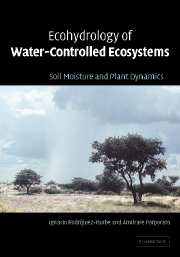Book contents
- Frontmatter
- Contents
- Foreword
- Preface
- 1 Introduction
- 2 Stochastic soil moisture dynamics and water balance
- 3 Crossing properties of soil moisture dynamics
- 4 Plant water stress
- 5 Applications to natural ecosystems
- 6 Coupled dynamics of photosynthesis, transpiration and soil water balance: from hourly to growing-season time scale
- 7 Plant strategies and water use
- 8 Seasonal and interannual fluctuations in soil moisture dynamics
- 9 Spatial scale issues in soil moisture dynamics
- 10 Hydrologic controls on nutrient cycles
- 11 Hydrologic variability and ecosystem structure
- References
- Species Index
- Subject Index
- Plate section
4 - Plant water stress
Published online by Cambridge University Press: 14 October 2009
- Frontmatter
- Contents
- Foreword
- Preface
- 1 Introduction
- 2 Stochastic soil moisture dynamics and water balance
- 3 Crossing properties of soil moisture dynamics
- 4 Plant water stress
- 5 Applications to natural ecosystems
- 6 Coupled dynamics of photosynthesis, transpiration and soil water balance: from hourly to growing-season time scale
- 7 Plant strategies and water use
- 8 Seasonal and interannual fluctuations in soil moisture dynamics
- 9 Spatial scale issues in soil moisture dynamics
- 10 Hydrologic controls on nutrient cycles
- 11 Hydrologic variability and ecosystem structure
- References
- Species Index
- Subject Index
- Plate section
Summary
The reduction of soil moisture content during droughts lowers the plant water potential and leads to a decrease in transpiration. This in turn causes a reduction of cell turgor and relative water content in plants, which brings about a sequence of damages of increasing seriousness. After a discussion of the links between soil moisture and plant conditions, the mean crossing properties of soil moisture, analytically derived in Chapter 3, are used here to define an index of plant water stress that combines the intensity, duration, and frequency of periods of soil-water deficit. Plant water stress is then studied under different climatic conditions, to analyze how the interplay between plant, soil, and environment impacts on vegetation conditions. The analysis of plant water stress presented in this chapter closely follows the paper by Porporato et al. (2001).
Soil-water deficit and plant water stress
From the level of the single plant to that of the entire ecosystem, the action of climate, soil, and vegetation is linked to plant response by two fundamental processes: the first one is centered around the soil moisture dynamics and controls the intensity and duration of the periods of soil-water deficit, while the second one regulates the impacts of water deficit on plant physiology (Figure 4.1).
Since plants get their water from the soil, many of the impacts of climate and soil are felt by plants through the filter of soil moisture dynamics. Effective drought conditions for plants are determined by soil moisture availability and not necessarily by precipitation scarcity (Stephenson, 1990, 1998).
- Type
- Chapter
- Information
- Ecohydrology of Water-Controlled EcosystemsSoil Moisture and Plant Dynamics, pp. 86 - 116Publisher: Cambridge University PressPrint publication year: 2005
- 1
- Cited by



